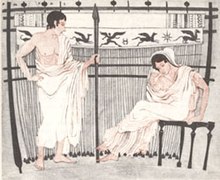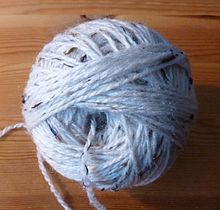Ball (textile)
A ball consists of a limited length of yarn that has been wound in the shape of a ball , cylinder or ellipsoid .
The untangling is used for the orderly storage and handling of a thread and secures it from being tangled and knotted until further use. It is next to the train and the coil (role) one of the commercial forms of yarn. In contrast to the skein, only the outer layer of a ball is visible, i.e. the last meters of the thread wound.
use
Usually knitting and crochet yarns made from wool , synthetic fiber mixtures and cotton are sold in the form of balls, as well as twine and parcel cord. Linen and silk yarn are poorly suited for being made up in balls because the outer turns slip too easily due to the stiffness and smoothness of these fibers.
Balls usually have a maximum size of around 10 cm * 15 cm. The length of the thread stored in it depends on its length and varies between 50 m and several hundred meters. Usually balls are sold by weight.
With each new winding, the mechanical ball winding arranges the thread next to the position of the previous winding by causing the winding mandrel around which the yarn is wound to wobble around its axis. Mechanical ball winders are also available for home use. After the winding process is complete, the finished ball is pulled off the core. Particularly with thin yarn, the cylindrical hole that is created is lined with a cardboard strip for stabilization in order to stabilize the ball; in such cases the line between coil and ball becomes blurred.
When winding by hand, the ball is created either over the thumb or with an initial piece that is folded into a small dock as the core. Here, too, it must be ensured that the thread windings are offset from one another, but this happens rather roughly crossed. Alternatively, you can wind a ball of hands in such a way that the thread can be removed from the inside, then the thread is looser. This ball remains dimensionally more stable than a commercially available machine-wound ball and does not roll away during unwinding. In Scandinavian countries, a slightly conical, wooden mandrel with a handle is widely used as an aid, which is called a Nostepinne .
history

Before the introduction of the bobbin (roll) and the shuttle in Europe, the ball was used in weaving with the weight loom to insert the weft thread .
A ball of wonder is a ball of yarn that is wrapped in small surprises and sweets that gradually unwind as you knit. In the 19th century, girls in particular were introduced to knitting in German-speaking countries with miracle balls.
Figuratively
“Ball” also means a rope that is twisted or knotted several times, or a ball of yarn that is incorrectly pulled up.
"Skein" is also used for confusion and confusion. “A ball in your head” means having confused thoughts. “Untangling a tangle” means untangling confused thoughts.
literature
Mabel Ross: Encyclopedia of handspinning . Loveland (Colorado) 1989, ISBN 0-934026-32-7
Individual evidence
- ^ Elizabeth W. Barber: Prehistoric textiles. The evolution of cloth in the neolithic and bronze ages with special reference to the Aegean. Princeton 1992, ISBN 0-691-00224-X (English), pp. 107-109
- ↑ Bärbel Ehrmann-Köpke: "Demonstrative idleness" or "restless activity" ?: Handicraft women in the Hanseatic middle class of the 19th century. Waxmann Verlag, 2010, p. 183.



